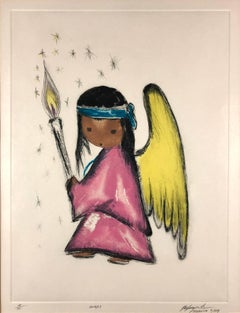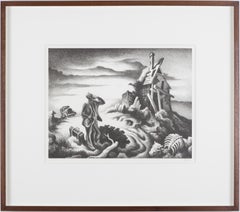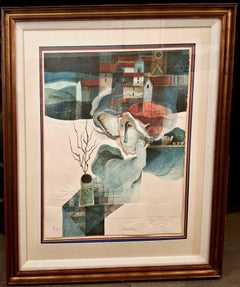Ted (Ettore) De Grazia Art
1
Overall Width
to
Overall Height
to
1
1
1
1
1
1
1
1
1
1
1
1
10,043
2,758
1,381
1,375
1
Artist: Ted (Ettore) De Grazia
Angel
By Ted (Ettore) De Grazia
Located in Missouri, MO
"Angel" 1979
Color Lithograph
Ed. 15/70
Pencil Signed and Number
Image: Approx. 25 x 20
Framed Size: 34 1/2 x 28 1/4
Category
1970s Modern Ted (Ettore) De Grazia Art
Materials
Lithograph
Price Upon Request
Related Items
Prodigal Son
By Thomas Hart Benton
Located in London, GB
A man raises his hand to his chin, his neck tilted and face turned to look at a dilapidated farmhouse, barely held together by planks of wood and exposed to the elements. Behind him ...
Category
1930s American Modern Ted (Ettore) De Grazia Art
Materials
Lithograph
“Winter” from the “Four Seasons Suite” Series
By Alvar Sunol Munoz-Ramos
Located in San Francisco, CA
This embossed, numbered and signed lithograph, part of the “Four Seasons Suite,” is by Alvar Suñol Muñoz-Ramos (b. 1935), a renowned Spanish ar...
Category
1970s Modern Ted (Ettore) De Grazia Art
Materials
Paper, Lithograph
$1,350
H 37.25 in W 30.5 in D 2 in
Down the River
By Thomas Hart Benton
Located in London, GB
In this sentimental work from 1939, Benton expresses his admiration for the rural lifestyle of the Midwest. He highlights the connection between man and the land by depicting two fig...
Category
1930s American Modern Ted (Ettore) De Grazia Art
Materials
Lithograph
Discussion
By Thomas Hart Benton
Located in London, GB
In this charming regionalist lithograph, Benton captures a classic Midwestern American scene: two men talking, drinking, and smoking together in a bar. Titled 'Discussion', the artwo...
Category
1930s American Modern Ted (Ettore) De Grazia Art
Materials
Lithograph
Dufy, Ascot, Raoul Dufy, Collection Pierre Lévy (after)
By Raoul Dufy
Located in Fairfield, CT
Medium: Lithograph on vélin d'Arches paper
Year: 1969
Paper Size: 20 x 41.3 inches, with bifold, as issued
Inscription: Signed in the plate and unnumbered, as issued
Notes: From the ...
Category
1960s Modern Ted (Ettore) De Grazia Art
Materials
Lithograph
$1,116 Sale Price
20% Off
H 20 in W 41.3 in
Vintage SIGNED Kitaj Poster, La Fabbrica, Milan (A Life 1975) woman in red dress
By Ronald Brooks Kitaj
Located in New York, NY
Printed in 1975, this poster features the encounter between an alluring woman dressed in red, and a man with his back to the viewer. The light of a streetlamp is beautifully imitated...
Category
Late 20th Century Modern Ted (Ettore) De Grazia Art
Materials
Lithograph
"Labor in a Diesel Plant" Machine Age American Scene Industrial Mid 20th Century
By Letterio Calapai
Located in New York, NY
"Labor in a Diesel Plant" Machine Age American Scene Industrial Mid 20th Century
Letterio Calapai (American 1902-1993)
''Labor in A Diesel Plant''
Wood engraving, 1940
17 x 10 1/2...
Category
1940s American Modern Ted (Ettore) De Grazia Art
Materials
Lithograph
$6,900
H 23 in W 16 in D 2 in
Old Man Reading
By Thomas Hart Benton
Located in London, GB
Accompanied by a lantern, an elderly man sits alone, engrossed in a newspaper. Benton used a lithographic process to draw and produce this image. He renders the face and paper well-l...
Category
1940s American Modern Ted (Ettore) De Grazia Art
Materials
Lithograph
“Europa and the Bull”
By Alvar Sunol Munoz-Ramos
Located in San Francisco, CA
You have to hand it to the bull. Not just taking Europa with his unassailable power (he is Zeus in disguise, after all) he brings along a retinue for his seduction of the beautiful P...
Category
1980s Modern Ted (Ettore) De Grazia Art
Materials
Paper, Lithograph
From “The Four Seasons Suite” Series
By Alvar Sunol Munoz-Ramos
Located in San Francisco, CA
This hand-signed, limited-edition lithograph with embossing is by the renowned Catalan Modernist artist Alvar Suñol Muñoz-Ramos, commonly known as Alvar. Part of “The Four Seasons” s...
Category
1970s Modern Ted (Ettore) De Grazia Art
Materials
Paper, Lithograph
$1,350
H 37.25 in W 30.5 in D 1.5 in
Marc Chagall King David (Pink Bible) Stone Lithograph Mid Century Modern
By (after) Marc Chagall
Located in Brooklyn, NY
Lithograph printed on Japon paper, not signed and not numbered. The lithograph is cataloged number 721 in "Chagall-The Lithographs" by D.A.P. The overall outside dimensions are 26 x...
Category
1970s Modern Ted (Ettore) De Grazia Art
Materials
Lithograph
$1,500
H 26 in W 23 in D 2 in
Théo Tobiasse "Cantate 51 de Bach" Signed 1979 Lithograph, Music & Memory Theme
By Théo Tobiasse
Located in Miami, FL
THÉO TOBIASSE – "CANTATE 51 DE BACH POUR LES JOURS DE LUMIÈRE"
⚜ Lithograph on paper ⚜ Hand signed and numbered ⚜ Conservation framed
SYMPHONIC FIGURATION FROM TOBIASSE’S FEMME SERI...
Category
1970s Modern Ted (Ettore) De Grazia Art
Materials
Lithograph
$3,800
H 49.75 in W 36.375 in D 1.5 in
Ted (ettore) De Grazia art for sale on 1stDibs.
Find a wide variety of authentic Ted (Ettore) De Grazia art available for sale on 1stDibs. You can also browse by medium to find art by Ted (Ettore) De Grazia in lithograph and more. Much of the original work by this artist or collective was created during the 1970s and is mostly associated with the modern style. Not every interior allows for large Ted (Ettore) De Grazia art, so small editions measuring 29 inches across are available. Customers who are interested in this artist might also find the work of Bernard Brussel-Smith, Irving Amen, and John DePol.


